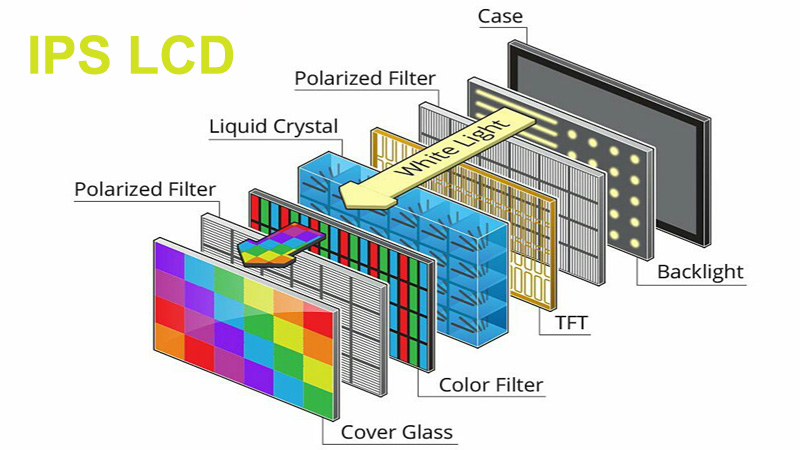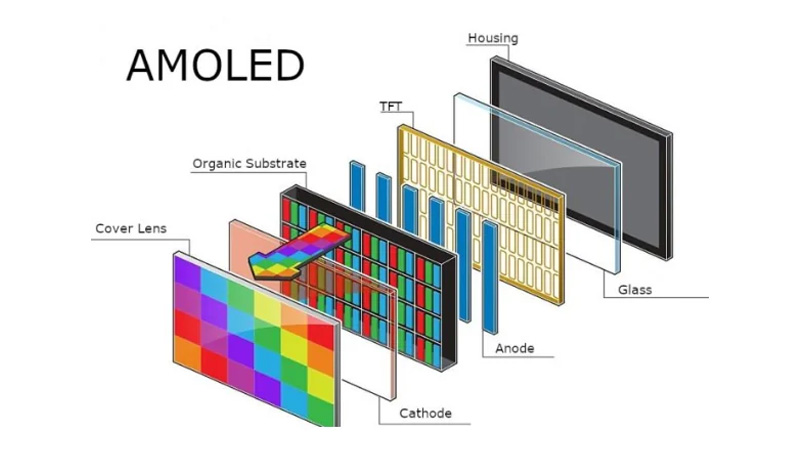
IPS Vs AMOLED: Differences and Comparison
If you’ve shopped for televisions or monitors at any point in the recent past, you may have heard the terms “IPS” and “AMOLED” being used in commercials, on advertisements, and marked on boxes. Both refer to certain qualities of televisions and displays, but what exactly do they stand for, and why are they important?
In this guide, we’ll explain what IPS and AMOLED mean, plus the differences between them, and the benefits of selecting one over the other.
1. What is IPS LCD?
In-Plane Switching, or IPS, is a novel improvement on traditional LCD screens, allowing for more vivid colors and wider viewing angles. To understand how IPS displays achieve this richness of image, however, you need to understand how most traditional LCD televisions work in the first place.
LCD screens – or liquid crystal displays – are made up of a few thin, layered components, which all work together to create the amazing images which make up your favorite movies, games, and television shows. The “liquid crystal” to which the name refers is a special kind of molecule that can, using electrical impulses, allow or not allow light to pass through in very small areas of the screen.
LCD screens are divided into a few layers. The backmost layer is a series of LED lights called the backlight, the light from which is diffused evenly across the display by a series of filters.
Then, polarizing filters are applied. Polarizing filters are a special material that can control the amount of light that passes through a screen or lens. When you place one polarizing filter over top of one another at a particular angle, they can allow all light through. However, when you rotate one polarizing filter 90 degrees, light is blocked from passing through the two sheets, creating black.
This is where the “liquid crystal” in the LCD name comes in. Engineers discovered special organic molecules, informally called liquid crystals, that can bend light in such a way as to “rotate” the light, mimicking the effect of physically rotating a polarizing filter. This ability to rotate the light can be turned off – creating black on your screen – or turned on – creating white – through the input of electrical signals. This gives these televisions the ability to create black and white images, and color is then applied by adding red, green, and blue color filters, which can be “mixed” to create the color of each pixel on screen.
In-Plane Switching refers to the way the liquid crystals twist. By changing the way, the liquid crystals rotate light, clarity of image and color is improved. Additionally, the depth of viewing angle in an IPS LCD is superior to other types of LCD displays – you can stand or sit at “off” angles and still see clear, distinct images with vibrant color.

2. What is AMOLED?
Active-matrix Organic Light Emitting Diode (AMOLED) is a type of OLED display system. With AMOLED displays, viewers are offered better colors, lower energy consumption, much higher contrast, and darker black values than any LCD display system.
AMOLED achieves this by altering the traditional way that light is used in display systems. As explained above, LCD displays use just one light – the backlight – to create the image you see on the screen; all the variations in light that create moving color images are created through the polarizing filters and color filters that are layered on top. In OLED displays, however, each individual pixel emits its own light rather than relying on the backlight, which has some huge benefits for consumers.
The “active matrix” part of the name AMOLED refers to the way in which the pixels on the screen are controlled. In passive matrix OLED displays, each pixel is addressed in sequential order in each row, one at a time. In active-matrix OLED displays, each pixel is addressed independently, meaning that pixels can change states much more quickly.
This can result in better response time, which may be important for some display users, like gamers and movie watchers. Most OLED screens available on the market are going to be AMOLED, and even many LCDs use an active matrix set up.

3. IPS vs. AMOLED: Which is Better?
Price
One disadvantage of AMOLED screens is that they are likely to be more expensive than IPS LCD screens across the board. Even though IPS is a newer improvement on LCD, AMOLED is an extremely new technology, which means it is overall more expensive to produce than LCD technology.
Plus, since AMOLED screens have individual LEDs for every pixel, this means that many, many LED components need to be produced. Even though the LEDs in IPS LCD screens produce more light overall, it’s generally much cheaper to build one backlight instead of potentially millions or billions.
Black level
Deep, inky blacks are one of the best features available on AMOLED screens. Like all OLEDs, AMOLEDs do not suffer from the problem of backlight bleed – where, even on a black screen, light from the LCD backlight bleeds through and is visible from the front.
LCDs, however, often suffer from this problem; after all, when black is on screen, the light isn’t “off.” Instead, the polarizing filter is “turned” for every pixel, but that doesn’t mean a little bit of light can’t leak through. This can be a huge problem when you’re watching movies or playing a game on an LCD screen, since the slight glow of black may ruin your immersion.
OLEDs, by contrast, have pixels that are controlled individually. When an area of the screen is supposed to be black, the pixels in that area turn off – they stop emitting light altogether. The result is deep, dark blacks that match real life darkness.
Brightness
It’s often thought that AMOLEDs can’t compete with IPS LCD screens in terms of brightness; those little pixels have trouble matching the output of a large white LED backlight. This is generally true – LCDs put out a lot lighter across the board.
However, it’s not true in every case, and OLED screens are improving rapidly in terms of brightness. Additionally, some buyers have viewing habits that don’t necessitate dramatic brightness. For some, it may be enough to use AMOLED screens in dark rooms, at night, indoors, or with the shades drawn.
Contrast
Due to the issues with LCDs achieving true blacks, it probably comes as no surprise that LCDs also struggle to produce high contrast images. Light colored images set over dark backgrounds can suffer from what is called “screen bloom,” where a bright white halo lights up the dark background, creating gray. This is because of the backlight – light is leaking out and coloring parts of the screen that don’t need to be lit up.
AMOLEDs do not have problems with screen bloom, and they can achieve deep, dark, highly contrast images.

Burn-in
For all their improvements on traditional IPS LCD screens, a major issue with OLEDS is the problem of burn-in. Burn-in refers to faint outlines of images or blotches of dim pixels that remain no matter what you’ve put on screen.
In OLEDs, burn-in occurs when users leave images up on screen for a long time; because the pixels may be producing light at uneven rates, causing some to lose luminance in the pattern of the image that was on screen, producing ghostly negatives or outlines. LCDs don’t have this problem because there is only one lighting component – the backlight – which means that the display loses luminance uniformly across the entire screen.
Manufacturers aren’t exactly sure how to fix burn-in currently; unlike image persistence on LCDs, burn-in is permanent, since the problem is with individual pixels beginning to dim. However, there are some steps that AMOLED owners can take to prevent burn-in from ruining their screens. Setting your screen to sleep when not in use prevents images from sitting stationary on your screen while you’re away, preventing pixels from burning out evenly.
Frequently changing wallpaper or using moving screensavers can also help, and dimming or removing task bars can make a huge difference. Lower-third graphics and logos from channels can also persist if you tend to watch the same TV channel every day and leave the channel on for hours – such as news stations – so be aware of changing your channel occasionally.
Energy Consumption
AMOLED displays and IPS displays are often contrasted in terms of energy efficiency, but the winner is kind of unclear. Here’s why:
IPS LCDs are generating power all the time, no matter what is on the screen. Even if you’re looking at dark images or pure black, IPS LCD screens are always backlit (except, of course, for when the display is turned off). AMOLEDs, by contrast, can turn off or dim the individual pixels for dark images or pure black, conserving energy. Tests demonstrate that OLED screens save around 40% more energy when displaying dark images compared with LCD screens.
However, AMOLEDs consume more power when they are trying to display bright whites. Those little individual lights just aren’t as powerful as one large backlight.
As a result, energy consumption in an AMOLED can be either higher or lower than an IPS LCD depending on what the user does with it.

4. Looking for Reliable LED Displays?
At LEDSINO, we offer a few high-quality LED display products and solutions, perfectly suited for clients in a wide range of industries and with a wide range of industry needs.
Whether you’re looking for affordable LED display rentals for an upcoming event, or you’re looking to purchase displays for your event center, conference center, auditorium, church, or arena, we can help you get set up with clear, vivid, and reliable LED displays.